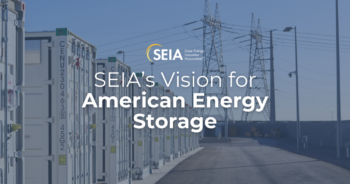We Need Solar and Storage to Address the Energy Emergency
Solar and Energy Storage Can Be Built Twice as Fast as Other Technologies
Photo courtesy of Silicon Ranch
President Trump recently declared an energy emergency. In his Executive Order, he states “We need a reliable, diversified, and affordable supply of energy to drive our Nation’s manufacturing, transportation, agriculture, and defense industries, and to sustain the basics of modern life and military preparedness.”1 Currently, the fastest and least expensive way to meet that goal is with solar and energy storage projects that are already under development.
Over the past decade, electricity supply has not kept up with demand. Electricity prices increased 20% from 2020 to 20232 due to lack of supply and needed upgrades to America’s transmission and distribution network. By 2030, U.S. electricity demand is expected to grow 7% from 4,300 terawatt-hours (TWh) in 2024 to 4,600 TWh in 20303. This growing demand will be driven by new datacenters, new factories, and new homes. It would be nearly impossible to meet that demand without solar and storage.
Developing a power plant takes years. All power plants, regardless of whether they are solar, gas, coal, or any other technology, require many of the same arduous steps to complete. These include site selection, application to interconnect to the grid, grid application analysis, grid upgrades, permitting, financing, equipment procurement, construction, and commissioning.
According to Energy Information Administration (EIA) data, some technologies face longer timelines due to complexity or their own supply chain constraints. The bar chart below shows how long different power plant technologies spend in each stage of development.
Solar and storage are the fastest technologies to develop and deploy. Not only are they much simpler to engineer, their supply chains are more robust than natural gas (which currently faces a bottleneck in gas turbine blades).
Natural gas combustion turbine plants are also fast to develop but they are specifically designed to provide extra power during short periods of high demand. They are 2.5x more expensive to build than solar and, in many parts of the country, more expensive to build than solar and batteries combined. Importantly, they’re also inefficient, leading to high fuel use and operating costs.
Gas plants also must be located near existing major gas pipelines, which have their own development and construction challenges.
Most new power plant capacity already under development are solar and storage. Replacing capacity already under development with other technologies will cause years of delay in meeting growing energy demand. Changing course and cancelling existing solar and storage projects would cost American taxpayers billions of dollars.
The world’s largest electric utility holding company, NextEra, recently announced plans to build gigawatts of additional gas generators, but noted that those generators are unlikely to be operational until at least 2030.
Solar and storage are particularly unique in their flexibility because you can quickly install them directly at your home and business. Residential installations often take as little as one day, offering unmatched energy security.
Solar and storage will be necessary to build a reliable, affordable energy infrastructure during President Trump’s second term. Otherwise, we will fall far short of our goals to create a strong U.S. electricity grid that can support growing demand for data centers, AI, and manufacturing.
1 Executive Order, Declaring A National Energy Emergency, January 20, 2025
2 EIA Electricity Data Browser
3 EIA AEO 2023



